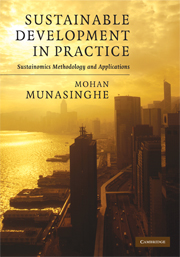Book contents
- Frontmatter
- Contents
- Foreword by James Gustave Speth
- Preface
- Part I Framework and fundamentals
- Part II Global and transnational applications
- Part III National and macroeconomic applications
- Part IV Sub-national sectoral and system applications
- 10 Energy-sector applications
- 11 Transport-sector applications
- 12 Water-resource applications
- 13 Ecological and agricultural system applications
- 14 Resource-pricing-policy applications
- Part V Project and local applications
- References
- Index
12 - Water-resource applications
Published online by Cambridge University Press: 05 August 2012
- Frontmatter
- Contents
- Foreword by James Gustave Speth
- Preface
- Part I Framework and fundamentals
- Part II Global and transnational applications
- Part III National and macroeconomic applications
- Part IV Sub-national sectoral and system applications
- 10 Energy-sector applications
- 11 Transport-sector applications
- 12 Water-resource applications
- 13 Ecological and agricultural system applications
- 14 Resource-pricing-policy applications
- Part V Project and local applications
- References
- Index
Summary
In this chapter, we examine how sustainomics principles may be applied to develop and manage water resources more sustainably. Section 12.1 describes the natural hydrological cycle and how interventions have affected it. Water and development linkages are examined in Section 12.2, including a review of the global status of water resources, water shortages and rising costs, poverty issues and sustainable livelihoods. In Section 12.3, a framework for sustainable water-resource management and policy (SWAMP) within a country is briefly outlined; this has many parallels with the sustainable energy development (SED) approach explained in Chapter 10. A rational and systematic integration of water-related social, economic, environmental and technical considerations is required within the broader framework of national sustainable development strategy. Sections 12.4 and 12.5 describe the practical application of SWAMP to a typical water-resources project involving groundwater for urban use in Manila, Philippines, including an analysis of the effects of harmful environmental externalities such as aquifer depletion, saltwater intrusion and land subsidence. Remedial policy measures are identified. Finally, Section 12.6 sets out the empirical example of a simple, low-cost, socially acceptable and environmentally desirable approach to purifying drinking water and reducing waterborne diseases that has yielded significant economic, social and environmental gains to poor villagers in Bangladesh. Another case study involving the evaluation of a classical rural water supply project in a poor African township is described in Chapter 15.
- Type
- Chapter
- Information
- Sustainable Development in PracticeSustainomics Methodology and Applications, pp. 391 - 423Publisher: Cambridge University PressPrint publication year: 2009



